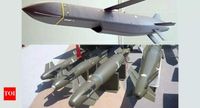In a significant escalation of military operations, India launched "Operation Sindoor" on May 7, 2025, targeting multiple terror camps in Pakistan and Pakistan-occupied Kashmir (PoK). This operation was a direct response to the tragic Pahalgam terrorist attack that claimed the lives of 26 civilians, including a serving Indian Navy officer and a Nepali national, on April 22, 2025.
The coordinated assault involved all three branches of the Indian armed forces—Army, Navy, and Air Force—and marked one of the most expansive retaliatory strikes in recent memory. According to government sources, the operation successfully hit nine sites linked to the terrorist groups Lashkar-e-Taiba (LeT) and Jaish-e-Mohammed (JeM), which have been long accused of orchestrating cross-border terrorism.
Among the advanced weaponry deployed were SCALP missiles, also known as Storm Shadow, and HAMMER precision-guided munitions. The SCALP missile, weighing around 1,300 kilograms (2,870 pounds), is designed for deep strikes against high-value, fortified targets. It has a range of approximately 300 kilometers and is capable of delivering precision strikes without crossing into enemy airspace. Its advanced navigation system combines inertial navigation, GPS, and terrain mapping, making it highly effective in targeting fortified structures.
In addition to the SCALP missiles, the Indian Air Force utilized HAMMER missiles, which stand for Highly Agile Modular Munition Extended Range. These precision-guided bombs are capable of striking targets at ranges of 50 to 70 kilometers and can be integrated with various guidance systems, including GPS, infrared imaging, and laser targeting. This modular design allows for high accuracy against both stationary and mobile targets.
The operation also featured the use of loitering munitions, commonly referred to as "kamikaze drones." These drones are designed to hover over target areas, providing real-time surveillance and the ability to engage threats either autonomously or under remote control. Their deployment was crucial in identifying and striking moving threats linked to the terrorist groups.
During Operation Sindoor, key targets included the JeM base in Bahawalpur and the LeT hub in Muridke. The Indian Army confirmed that the strikes were focused, measured, and non-escalatory, aimed solely at dismantling the infrastructure of the terror outfits while avoiding engagement with Pakistani military installations.
Government officials reported that more than 90 terrorists were believed to have been neutralized in the operation, which was conducted under the cloak of darkness to maximize stealth and precision. The use of Rafale fighter jets, armed with SCALP missiles and HAMMER bombs, allowed for high-impact strikes deep inside enemy territory.
Operation Sindoor represents a significant shift in India's counter-terrorism strategy, emphasizing precision warfare and the use of advanced technology to achieve military objectives. This operation is seen as part of a broader strategy to deter future terrorist attacks and to respond decisively to threats against national security.
In the wake of the operation, Pakistan condemned the strikes, labeling them an "act of war." The Pakistani government has historically denied allegations of supporting terror groups and has called for international intervention in response to India's military actions.
Analysts have noted that the precision of the strikes, facilitated by advanced weaponry, reflects a growing trend in modern warfare where technology plays a pivotal role in achieving strategic objectives without incurring high collateral damage. The integration of various military branches and the use of real-time intelligence further underscore the sophistication of India's military operations.
As tensions escalate in the region, the implications of Operation Sindoor extend beyond immediate military objectives. The operation highlights the ongoing conflict between India and Pakistan over terrorism and border security, with both nations locked in a cycle of retaliation and counter-retaliation.
Looking ahead, the Indian government has indicated its commitment to maintaining a robust defense posture while seeking to minimize civilian casualties during military operations. The success of Operation Sindoor may pave the way for future military strategies that prioritize precision and technological superiority in counter-terrorism efforts.
In conclusion, Operation Sindoor not only represents a decisive military response to terrorism but also signifies a transformative approach in India's defense strategy, leveraging advanced technology to achieve tactical advantages in a complex geopolitical landscape.



